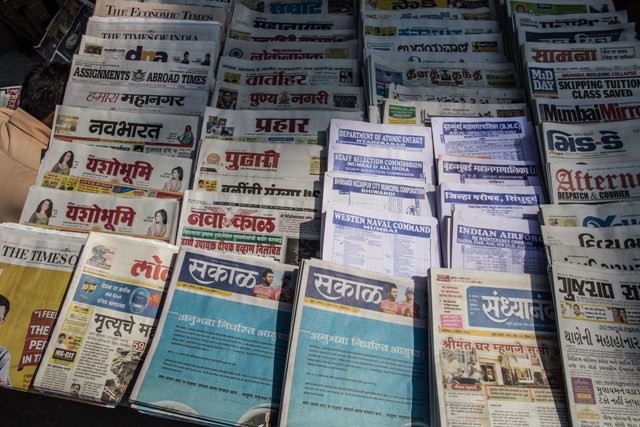 Newspapers on sale in Mumbai. [photo: Jeremy Graham / Alamy Stock Photo]
Newspapers on sale in Mumbai. [photo: Jeremy Graham / Alamy Stock Photo]
[This is an excerpt from an article in The Round Table: The Commonwealth Journal of International Affairs.]
Introduction
Although the Covid-19 pandemic impacted all mass media platforms, newspapers bore the brunt in many cases. Newspaper copies are presumably touched by many before they finally reach the reader. For this reason, many readers refused to accept newspapers in their homes during the lockdowns for fear of surface transmission of the Covid-19 virus. In the absence of newspapers, such readers gravitated towards other forms of news media, and television or the internet were the best choices for many of them. As a result, in many areas, the television audience grew as Covid-related restrictions were put in place while newspapers lost readers (Barthel et al., 2020).
Before the pandemic hit India, newspapers reported a steady decline in readership. In the years that preceded the pandemic, the challenge for the Indian newspaper industry was falling audience numbers. According to a Reuters Institute survey in 2019, only 16% of the respondents among English-speaking Indians under 35 admitted to getting their information from newspapers. Among the respondents over 35, only 27% identified newspapers as a primary news source (Nielsen et al., 2019).
Newslaundry, in February 2020 (a month before a pandemic was declared in India), quoting the Indian Readership Survey (IRS) data, asked whether the Indian newspaper industry was dying as a steep decline in print readership was reported by many newspaper companies. Two English language newspapers also shut down city editions, presumably due to falling readership and advertising volumes (Joseph, 2020).
As the Covid-19 pandemic swept through India, the newspaper industry reported a sharp drop in advertisement revenue. The Newspaper Society, a body of about 1,000 publishers, reported a net loss of approx. $2 billion in advertising revenue. This loss forced many newspaper companies to retrench journalists and slash salaries (Kalra, 2020).
Multilateralism in South Asia during the COVID-19 pandemic: an Indian perspective
Covid-19 and Commonwealth countries – A special Journal edition
Bend, crawl, or fight? The role and record of the press in a democratic India
Though Indian newspapers reported a recovery in revenue post-March 2021, they were way off their financial targets. The FICCI-EY Report of March 2021 stated that the pandemic had wiped off 41% of the projected advertising revenue from the Indian Newspaper industry. Another concern was a drop in circulation revenue (from paid subscribers) by as much as 24%, which indicated an exodus of print media audiences, presumably to digital media (Federation of Indian Chambers of Commerce and Industry [EY-FICCI], 2021).
Already dealing with challenges, the Indian newspapers received an exogenic shock during the first few Covid lockdowns when newspaper circulation was heavily impacted due to fears of surface transmission of the Covid-19 virus. During the first nationwide lockdown in March 2020, English language newspapers were the first to report a halt in their production as people stopped accepting newspapers in their homes. It was an unprecedented event in the history of Indian media (Ramesh, 2020).
After this crisis, the newspaper industry evolved rapidly, which included adapting to the new reality of their staff working from home. This happened against the backdrop of the two severe Covid-19 pandemic waves between March 2020 and September 2021. The pandemic acted as a catalyst affecting the change. As Sevanti Ninan (2021) notes, ‘A pandemic can speed up a change in the making. In 2020, Covid-19 became the trigger for a media consumption shift that was both swift and brutal in its consequences’.
This process of evolution of a media platform, triggered by external forces, finds resonance with the Mediamorphosis Theory, which proposes that, influenced by external factors, media platforms constantly upgrade themselves and eventually evolve.
All forms of communication are, as we shall see, tightly woven into the fabric of the human communication system and cannot exist independently from one another in our culture. As each new form emerges and develops, it influences the development of every other existing form over time and to varying degrees’. (Fidler, 1997)
After the pandemic, an evolved Indian newspaper industry has absorbed most of the shocks triggered by the pandemic and has recovered lost ground. Thanks to improved production processes and other factors, Indian newspapers are again a preferred news medium for many urban Indian readers. The advertising volumes have also shown a significant rise signalling a return to normalcy (Federation of Indian Chambers of Commerce and Industry [EY-FICCI], 2022).
Soumyadipta Banerjee is with the School of Media and Communication, Manipal University, Jaipur, India & Aditya Kumar Shukla is with the Directorate of Online Education, Manipal University.



